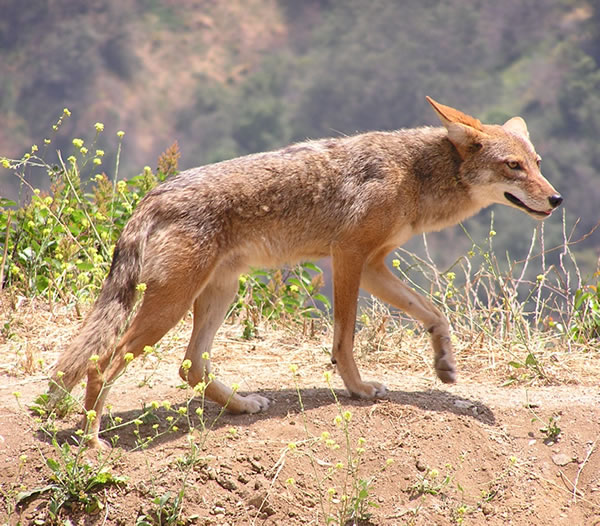
The coyote’s scientific name comes from the Latin words for “dog” (Canis) and “barking” (latrans).
FAMILY
Canidae, with domestic dogs, wolves, foxes, and dingoes
RANGE
Throughout North America, from Mexico to Canada
Important Environmental Factors

Below 1,000 meters (though they may be found at higher elevations)

Any level, including areas that are over 80% paved or compacted ground

Moderate to high variation in seasonal rainfall
Habitat and Behavior
The range of the coyote has expanded from its grassland origins to include habitats from Alaska to Panama, as well as most of the contiguous United States. Their resilience to change has allowed coyotes to persist in highly urbanized environments like Los Angeles, where they are fairly common due to a reliable food supply. Their diverse diet ranges from fruit and insects, to household food waste, to deer and birds (the scat or droppings of a coyote are easy to distinguish from dog droppings by the inclusion of fur or bones) [1]. Coyotes walk between 5-15 kilometers a day in search of food, generally along established trails or roads. They may travel solo, as monogamous pairs, or—when food is more abundant—in packs of up to 10 individuals. Pairs will sometimes share territory with relatives or their offspring, which they raise in dens. As a crepuscular species, they are most commonly observed around sunset or sunrise.
Interactions with Humans
Coyotes appear to be thriving in Los Angeles, and factors like impervious surfaces (i.e. concrete and asphalt) and nighttime lights are some of the best predictors of coyote sightings. Unfortunately, coyotes have long been considered a problem in urban, suburban, and agricultural settings because of attacks on pets, livestock, and sometimes humans. Though most coyotes prefer to avoid people, some have become well-adapted to human presence. Steel traps, poisoned baits, and hunting have been suggested as controls for their increasing numbers in urban areas. Some of these control methods are now illegal, but public education is an important part of managing human-coyote interactions.
Wildlife Encounters
Homes and property are less attractive to coyotes if there is no access to food sources. You can reduce their access by: covering trash, harvesting ripe or fallen fruit, not feeding feral cats (this food may also attract coyotes), enclosing backyard poultry and other animals, and feeding and keeping pets indoors (particularly at dawn or dusk) [2]. When walking pets, keep them on a leash. If you do encounter a coyote, do NOT approach the animal – including coyotes that appear sick or injured. Back away from the encounter but do not turn your back on the coyote.

Data source:
Species records provided by iNaturalist
References:
- Timm et al. (2007) UC Agriculture and Natural Resources Pest Notes: Coyotes. Publication 74135.
- Quinn (2016) Coyotes in California’s Urban Areas. UC IPM. [link]